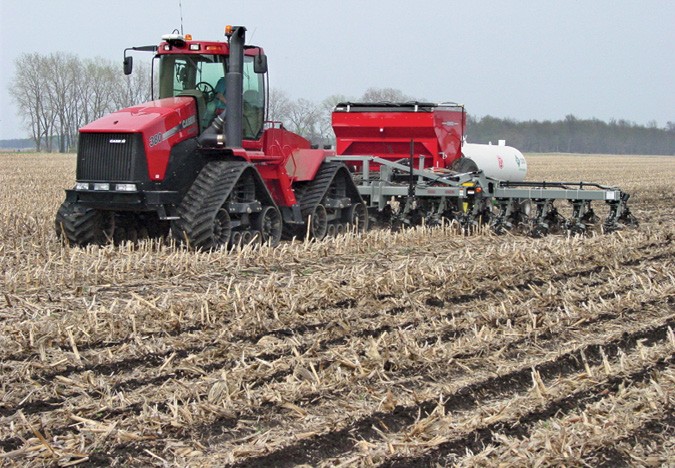Avoid These 10 StripTill Mistakes
Post on: 16 Март, 2015 No Comment

Advertisement
Talk to anyone who has tried strip-tilling corn, and you’ll find a lot can go wrong at first. Yet relatively few farmers quit the practice once they’ve begun.
“Since we have fewer passes over the field with strip-till, we can get the crop in more efficiently (than with full-width tillage),” says Jordan Qualm, who does custom strip-tilling for roughly 10 different farms near Jasper, in southwest Minnesota. “The soils warm up a lot faster than they do with no-till, which allows us to plant a little earlier. With controlled-traffic patterns, we’re also able to get into fields in the fall when it’s wet and not worry as much about compaction or getting stuck.”
Strip-till, which creates a 6-8-in.-wide cultivated seedbed in between undisturbed crop residue, provides other important agronomic and economic benefits. They include increased soil fertility through better placement, less fuel and machinery use due to fewer trips over the field and increased yields compared to no-till corn, says Qualm. A reduction in environmental concerns is another feature of strip-till compared to a full-width tillage system, he adds.
Although now an old hand at strip-till, it wasn’t long ago that Qualm, who farms with his uncle, Bryce Kindt, was the student. “I first learned about strip-till at South Dakota State University (SDSU) but then learned more at farm shows, searching the Web and talking to other farmers who’ve done it,” he says. “We also hired people with auto-steer to strip-till for us. That’s how we found out which equipment works best.”
Qualm and his uncle decided to do their own strip-tilling after they purchased an AutoFarm RTK (real-time kinetic) auto-guidance system. “We can strip-till perfectly straight with this technology,” says Qualm. “As a result, we’re able to strip-till for people with any planter size on 30-in. rows.”
Without auto-guidance or someone very competent to both create the strips and plant into them, yields will likely suffer, says Gyles Randall, a soil scientist at the University of Minnesota Southern Research and Outreach Center, Waseca, MN. “If you can hire someone who is set up with all the equipment and expertise to stay on the strips, that would be a real positive,” he says. “You really need a high level of management for this to work.”
Yield boosts can occur when the system is working properly, particularly during a dry year, says Qualm. “The corn looked really good last year, even after it got dry,” he says. “Compared to conventional tillage, the yield benefit was 6-12 bu./acre better with strip-till.”
During dry conditions, strip-till does provide a yield boost, agrees Rock Arnold, who has strip-tilled corn for the last three years near Hazel, SD. “When there is ample moisture, strip-till doesn’t yield much better than full-width tillage,” he says, “but strip-till corn has given us about 5-10 bu./acre more on average, and about 20 bu./acre more on soils that tend to be droughty.”
Still, farmers won’t likely see the full benefits of strip-till right away, cautions Steve Hawthorne, who has strip-tilled corn for seven years near Gibson City, IL. “After a few years, the benefits of erosion control and water infiltration start to take effect,” he says. “Over time you’ll also get better at staying on the strips.”
Strip-tillers like Hawthorne, Arnold and Qualm and university experts like Randall readily share advice with farmers who want to avoid making mistakes when first implementing a strip-till corn system. Their top 10 strategies to evade common pitfalls are:
- Select suitable fields
“The most common mistake with strip-till is that farmers try it in the wrong place to begin with,” says Jim Gerwing, SDSU Extension soils specialist. “They either use it on really wet soils that would respond better to full-width tillage or on topography with too much slope, too many curves or odd-shaped fields that make it difficult to stay on the strip.”
Farmers who want to try strip-till should start on drier soils first, where the potential for a yield boost is greatest, agrees Arnold. Choosing flatter fields is also a good idea if you don’t have a good system for staying on the strips, he adds.
“Unless you have an auto-guidance system with RTK, it’s hard to stay on the row, especially on odd-shaped or contoured fields,” says Gerwing. “To line up properly, you also |have to pair the row width of your strip-tiller to the row width of your planter.”
It can sometimes be very difficult to see the strips, particularly at night, if you don’t have a good marker or auto-guidance system, says Hawthorne. “An inability to see the strips really limits how much you can get done in a day,” he adds.
The accuracy of crop input placement will also suffer without a good guidance tool, says Qualm. “You need the sub-inch accuracy from RTK auto-steer,” he says, “to make sure the seed and fertilizer are put in the right place.”
However, auto-steer isn’t always perfect, notes Hawthorne. “Our satellite reception gets pretty iffy sometimes,” he says. “It may take a while to get all the bugs out of a new guidance system.”
“We make our strips in the fall mainly because we’re less busy then, but also because things just work better,” says Qualm, who applies dry fertilizer (130-30-30) in the fall with an air cart while strip-tilling with a Red Ball 12-row strip-tiller. “The soil is drier, so it breaks up easier and results in fewer clumps to deal with than in the spring,” he explains. “The fall-applied fertilizer also has time to break down a little.”
Risk management is another big reason to build strips in autumn. “By strip-tilling in the fall, I leave myself a way out,” Qualm adds. “If I waited to do it all in the spring and the weather turned wet, I’d be out of luck.”
In some years, wet weather delays harvest, snows come early, and farmers can’t make strips in the fall, points out Gerwing. “It’s difficult to strip-till in the spring, because many times conditions are too wet,” he says. “Other years it’s more difficult to get good seed-to-soil contact if the strips are made in the spring, because the soil is too loose and it’s not firm enough to plant in.”
However, Arnold prefers making strips in the spring, mainly because of better nitrogen (N) management. “The best way to manage N is to apply it in the spring,” he says. “We place 27-0-0-1 in strips with the strip tiller and 9-24-3 and potassium with the planter.”
With his modified machinery, Arnold’s spring-built strips are also easier to see, he adds, because they are blacker and leave no trash in the row. “We have Dawn Equipment Pluribus strip-till units on an Ag Systems anhydrous toolbar that we modified into a 24-row, 30-in. machine,” says Arnold. “Unlike most strip-till units, it uses trash wheels and coulters to prepare the seedbed and place the fertilizer 3-4 in. deep. It makes a blacker strip than most shanked strip-till machines. That helps warm soils up faster, and it tills almost like a rotary tiller, which makes a better seedbed for spring conditions.”
“Our planter finger units roll the trash away so the trash doesn’t interfere with seed-to-soil contact,” says Hawthorne, who uses a DMI anhydrous toolbar with a regular mole knife and 18-in. cover disks with a smooth edge to help shape a mound in the strip. “Unless you get off the cultivated row, strip-till will give you the perfect seedbed,” he adds.
Qualm uses a John Deere 1760 12-row planter with Yetter shark-tooth residue managers to keep trash away from strips. “You need to have good residue managers on your planter,” he says. “For corn after corn, you need to have a good corn stalk chopper.”
Normally, Qualm strip-tills soybean stubble in the fall to plant corn the following spring. “However, we’ve experimented with strip-tilling corn on corn and it’s worked really well,” he adds. “We pulled an Orthman row-stalker through the field that cut the corn stalks right at the ground and threw up a little dirt, which allows the strip-tiller to run through the row without plugging up.”

Hawthorne also has experience strip-tilling corn on corn. To avoid trouble with the root balls he strip-tills between the old corn stalk rows, rather than on top of them.
You may want to purchase a strip-tiller with individual parallel linkage so that the row units flow over the ground like a planter to achieve a consistent fertilizer depth, advises Qualm. Parallel linkage would be helpful, agrees Randall, who cautions farmers to avoid making strips past 6-8 in. deep.
Although strip-till generally requires less horsepower than most full-width tillage systems, farmers still need adequate horsepower for their strip-till anhydrous applicator to match up with their planter width, points out Bob Frazee, University of Illinois Extension natural resources educator. Farmers will need slightly more horsepower if they also apply phosphorus (P) and potassium (K) while they strip-till and apply anhydrous in the fall, he adds.
“I would avoid older equipment when doing this,” says Randall. “It’s important to use the best machinery that you can afford, and the newer technologies will allow strip-till to work optimally. Also, as farm units become larger, those fall operations become increasingly more time sensitive. It may require an investment in larger strip-till machinery to ensure strips are made before winter.”
“After the strips are built, keep your tire tracks off the ridges when you’re running sprayers or fertilizer applicators to avoid compacting the seedbed,” cautions Frazee. “An RTK auto-guidance system will also help to control traffic patterns and minimize compaction.”
It’s easy to be caught off-guard by weed pressure when first switching to strip-tillage, says Hawthorne. “Some funny weeds will start showing up due to less tillage, so you need to think a little more about weeds. You’ll also need to be more flexible in timing herbicide applications to address changes in any weed species that occur.”
If you have landlords, do your homework and have your facts in hand before approaching them about a switch to strips, says Hawthorne. “Some landlords might disagree with you about a move to strip-till,” he says. “If they are retired farmers, they tend to think that tillage is the best way to go and they may be resistant to change.”














